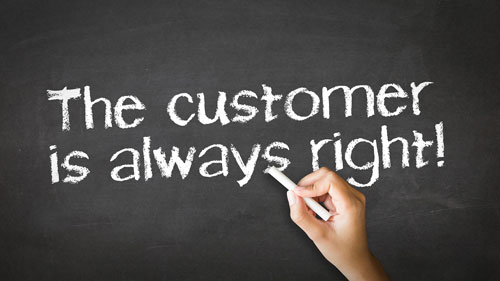Is the customer always right? How far should a company go to satisfy their clientele or customer base?

Is there a point when satisfying the customer is actually harmful to the enterprise or as the saying goes, is the customer always right? In this article I’ll share my opinion as to the validity of this statement and where to draw the line.
So, who originally coined the phrase “The customer is always right”? There is a century old dispute about who should actually get the credit.
The American’s believe it is Marshall Field of Marshall Field’s department stores and the British believe the phrase was coined by Harry Gordon Selfridge the founder of London’s Selfridges store.
The dispute centers around the fact that Selfridge was actually born in Wisconsin and worked for Field for nearly 11 years prior to opening his store in London. Regardless of which man coined the phrase many have adopted its use over the years as the premise for their philosophy on customer service and satisfaction.
I believe that all businesses should use great care and concern when determining how their customers are treated. The time, energy and cost associated with acquiring a customer are substantial and likewise the benefits of retaining customers are considerable.
That being said, I also believe there is a point where customers can begin to abuse the good will of the merchants and service providers who work hard to earn their business. The good news is that most customers are well worth the time and effort expended to retain their business over the long haul.
So, when does a customer cross over to the dark side and become your worst nightmare? Regrettably, experience has shown me that a small percentage of customers/clients live to wield their perceived power over their merchants, vendors, suppliers and professional service providers.
These customers are the proverbial “squeaky wheels” that demand to be greased. These are the verbally abusive customers who expect special consideration and whose demands far exceed the boundaries of reason. There is in fact a point where “bad customers” can erode margins, negatively affect morale or even tarnish a brand. These customers not only are not right, they deserved to be fired…
The following tips will help you minimize the amount of bad customers served by your enterprise and will show you what to do once a customer crosses over to the dark side:
1. Align Expectations: Where possible, and especially if your business has the luxury of choosing your customers make sure that mutual expectations are both defined and aligned at the outset of the relationship. Insure that your client understands what types of customer behaviors will be accepted and what types of behavior will not be tolerated.
2. Develop Customer Scorecards: You should actually profile your clientele such that you understand the difference between good accounts and bad accounts. Much like you have performance reviews for your employees you should conduct an analysis of how your customers are performing. Not all accounts are accretive and more accounts than you think may in fact be dilutive.
3. Turnover Bad Accounts: When a client is identified as being a bad account either not capable of being saved nor worthy of salvaging you should fire the client. I am constantly looking to upgrade the bottom 10% of my client base either by improving account performance or by firing the client and replacing that business with a better quality account.
I feel privileged to serve my clients and am thankful for the opportunity to earn their business, but I also believe that the relationships should be reciprocal in nature and that they should respect the caliber of advice and quality of representation they receive.
About the Author
Mike Myatt is the Chief Strategy Officer at N2growth. N2growth is a leading venture growth consultancy providing a unique array of professional services to high growth companies on a venture based business model.




